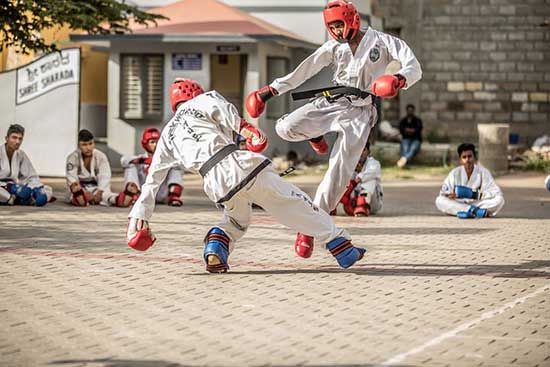The Taekwondo Belt structure exists in three categories, namely the Gup, Poom, and Dan, which are different levels available to understand the Taekwondo practice and tradition.
Levels may change according to the schools they are taught in, but the standard structure of the school belt is strictly followed.
The Poom belt is awarded during the rank transition in students from junior belts to adult degrees. A student under the age of 15 who attains a black belt is awarded the Poom belt, which indicates fulfillment of the competent standards in practice.
However, the Poom belt indicates that the student does not hold the same capacity for self-defense as an adult.
The standards differ as the student needs to be fully equipped with the required adult capacity. However, students who attain the Poom belt show impressive potential in Taekwondo; the belt is half red and half black.
Contents
How long does it take to get it?
Different Taekwondo schools offer varied craft syllabus that can affect how long the student attains the Poom Belt.
Attaining the Poom belt means the student must first complete the 9 Gups and pass the required academic standards.
This can take months and even years to attain because of the nature of training and the concepts taught.
It may take a dedicated student three to five years to complete the training. In the process, discipline and great dedication are essential to learning the different skills offered and mastering the philosophy of the craft.
Different schools often offer curriculums whereby the student must pass first before continuing to another stage.
The 9th Gup, critical to awarding the Poom belt, is indicated by the red and black belt, which signifies the student’s proficiency and maturity in the craft.
The holder is presumed to have both practical and theoretical skills to advance. This stage covers all nine stages with the different formations and movements adhered to for one to pass the stage.
What tests are required to get the Poom Belt in taekwondo?
The Poom black belt test is essential to the student if focusing on moving from one level to the other.
One of the most critical aspects of the testing is the minimum age which is a student who is less than 15 years.
Testing at this stage involves the techniques and theories taught over the years. Kicking techniques are tested whereby the student must show proficiency and demonstrate the advanced techniques used for self-defense.
Forms are also essential and focus on 14 traditional movements through which the student should clearly understand the stances.
Proficiency in sparring is also essential, and the student must show their sparring combinations that offer effective defensive techniques using good footwork. Techniques such as self-defense, grappling, and breaking are necessary for this test.
Apart from the physical techniques that are tested, written examinations and personal essays are included in the process to ensure the student understands Taekwondo’s skills and philosophy.
As a student, effective delivery is essential to create a flawless transition to the Poom belt level. Creativeness is also crucial in this stage, which can be incorporated into the daily delivery of techniques that build up to good progress.
What is the next level after this belt?
After the student has attained age 15 and above, they are qualified for the 1st Dan level, which can be awarded a year after attaining the Poom Black Belt.
Attending the 1st Dan requires a student with immense potential and dedication to the craft. The 1st Dan in Taekwondo is a clear indication of attaining a reasonable level and a sign of pride to the student.
This stage opens the student to more practice periods in which the student shows tremendous potential in achieving Taekwondo. There is still much to learn at this stage, even after having experience.
Advanced techniques are commonly added in the process; some may be associated with instructors at this level.
However, experience is essential to achieve titles in the craft. Therefore, this stage is critical in forming the necessary experience and expertise around Taekwondo.
Progressing from the 1st Dan to the 2nd Dan can take a year or two, depending on your experience.
The Dan level is, however, only applicable to students who are above 15 years. Even with the varied curriculums in different schools, the standard belt structure is referred to often and plays a critical role in forming Taekwondo students.
Take away
The Poom Belt stage is a critical and prestigious stage as it shows the total dedication of students, especially those below the age of 15.
Student consistency and dedication often help students get to the Poom belt stage. after completing the 9 Gups, it is clear that the student has practical foundation skills in Taekwondo and can be introduced to even more complex techniques.
Developing these skills is essential as the following levels demand proficiency and understanding of the stages and their intensity.




